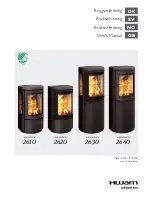
~
14 ~
ADDITIONAL INFO
(FOR BOILER MODEL ONLY)
Boiler Connection
The advanced Back-Boiler fitted in your Stove must be installed in Compliance with all relevant
Building Regulations and in accordance with Central Heating Standard EN 12828 whilst
complying with local Water Supply Regulations. Guidance and further information is available
from your Local Water Supplier.
The Stove must NOT be operated until the back-boiler is
connected and has water connected to it, operating the stove before the Back-Boiler is connected
may cause damage to the boiler and stove alike, this will also terminate the guarantee. A suitably
qualified water heating engineer is recommended for connecting the Boiler of the Stove, this may
be a separate installer to that of the Chimney/Flueway.
This Back-Boiler may be effectively
installed or linked in with an existing gas or oil circuit if a neutralising vessel is installed.
The ready fitted boiler connections have 1“BSP threads. The Back-Boiler in your Stove is only
suitable for Indirect Closed Circuit Systems for heating Domestic Hot Water and Radiators, the
quantity of which will require calculating by your installer and is largely dependant upon the size
of radiators, pipe work length and pipe work diameter.
When the Back-Boiler is heating domestic hot water an Indirect Domestic Hot Water
Cylinder with an integral heat exchanger is required, this is readily identified on the Cylinder as the
protruding threads are male fitting, do NOT confuse this with an unsuitable Direct Cylinder which
has female threads. Pipe work where applicable from the Back-Boiler to the open vented gravity
Feed & Expansion Tank must rise continuously and will require a 25mm water clearance from
below the warning pipe. All pipe work and fittings must comply with all relevant fitting and
European standards.
A Drain Off Cock must be fitted to all low points of the system. A method of allowing complete
drainage of water from the system must be incorporated.
An adequate means for preventing
backflow of water into other parts of the system must be provided.
The Indirect Closed Circuit System may also require, (dependant upon type of installation):
A thermostatic valve to be fitted to all radiators (unless heat leak).
A Heat Leak radiator , towel rail or similar appliance fitted into the primary flowing circuit
to dissipate excess heat from the Back-Boiler. This appliance must be at least 10% of the
Back-Boiler output and must NOT be fitted with a control valve.
A pump in the primary system to assist the flow.
Pipe thermostats to prevent over heating or cold water flowing through the circuit.
Injector Tees to assist the circulation.
The Back-Boiler must be tested upon completion of installation.
Usage of thermostat
As for the large boiler type stove HFB-443, there is one more primary air inlet at the back of the
stove. It can be controlled either by hand or by a thermostat. If your option is a stove with a
thermostat, the thermostat is set at close or “0” position by the manufacturer and you may reset it at
an open position according to your own needs. Our suggestion for re-setting the thermostat is as
under:
Set it to 0 ~ 3 position when you connect your stove to 5 ~ 10 radiators to heat an area of 70 ~ 110
㎡
Set it to 3 ~ 6 position when you connect your stove to 10 ~ 15 radiators to heat an area of 110 ~ 150
㎡
Set it to 6 ~ 8 position when you connect your stove to 15 ~ 18 radiators to heat an area of 150 ~ 180
㎡



































